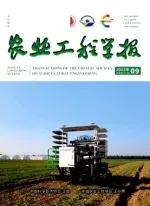基于系统动力学的稻田塘堰系统水转化模拟及验证
2017-10-14胡能杰邵东国乐志华农翕智
胡能杰,邵东国,陈 述,乐志华,农翕智
基于系统动力学的稻田塘堰系统水转化模拟及验证
胡能杰,邵东国※,陈 述,乐志华,农翕智
(武汉大学水资源与水电工程科学国家重点实验室,武汉430072)
为了描述稻田塘堰系统水转化过程,以水量平衡原理为基础,建立稻田塘堰系统水转化系统动力学模型。利用漳河灌区三干渠中游区域尺度塘堰日水位观测资料对模型进行检验,模拟结果的复相关系数、Nash-Sutcliffe系数和均方根误差分别为0.90、0.79和0.155 m/d。在浅水灌溉模式下,对研究区域内塘堰调蓄方式进行动态模拟,结果表明,塘堰在完全调蓄时可以保障作物充分灌溉,在部分调蓄与不调蓄时作物分别在第72天和45天发生水分胁迫,塘堰灌溉对保证作物正常生长天数具有显著效果。当塘堰完全调蓄时,在浅水灌溉、湿润灌溉及间歇灌溉模式下,塘堰最低蓄水量占最大蓄水量的比例分别为2.0%、18.9%和41.3%,塘堰的有效水利用率分别为84.7%、80.9%和67.7%。研究可为稻田塘堰系统合理利用雨水资源、灌溉管理提供理论依据。
水位;水管理;系统科学;塘堰灌溉系统;系统动力学;水量平衡;模拟
0 引 言
灌区水转化过程直接影响灌溉水利用效率。受地形地貌、土壤植被、水文地质等自然条件和灌排系统建设、农业生产等人类活动双重作用,不同地域灌区的水转化过程存在明显差异。为此,人们开展了大量蒸发蒸腾、渗漏、产汇流及地下水补给、排泄等试验观测和研究,获取了一些重要的田间水转化或局部水文过程观测数据。Moussa等[1]研究了水管理措施时空分布对灌区水文过程的影响;Davies等[2]研究了局部蓄水设施条件下的水文过程;蔡明科等[3]提出了节水对水平衡的影响及其评估模型;Janssen等[4]研究了土地利用、耕作与种植等农业措施对水转化和利用效率的影响;Liu等[5]研究了土壤水分时空变异性及水平衡要素的尺度特征。受沟塘、土壤、作物等空间变异性影响,灌区水转化过程均具有随机性。在灌区水转化结构、机制及其效率、生态环境效应等问题并不清楚条件下,传统田间试验观测及数值分析方法,难以揭示灌区水转化特性及其效率提升机制。需要深入研究灌区复杂条件下的水转化试验观测及其过程描述方法、特征参数、调控机制及效率响应规律。中国南方水稻灌区分布着众多塘堰。通过储存农业排水、灌溉退水和收集雨水,塘堰可以为稻田提供补充性灌溉,是回归水重复利用的主体。由于具有储水灵活、供水及时可靠等特点,许多农业和灌溉专家都对塘堰灌溉十分认可[6-10],并认为塘堰对节水灌溉的成功实施和确保干旱年作物生产供水起到重要作用[11-14]。区域气候和土壤质地、塘堰规模和用水规则、田间的灌溉管理措施等深刻影响着稻田塘堰系统水资源的循环使用[15-18]。Kim等[19]建立了稻田日水量平衡模型,并模拟评估了水稻生长季稻田的储水量。毛战坡等[20]定量研究了水塘系统对流域水资源短缺及径流峰值的调控功能。但目前缺少完善的理论方法描述稻田与塘堰间的水转化动力学过程。系统动力学适用于研究复杂系统的结构、功能和行为之间的动态关系,借助于强大的图形编辑环境和政策分析工具,建立规范的、定量的模型。因此,本研究考虑塘堰及稻田的水平衡要素,基于系统动力学的建模思想和Vensim软件,构建了稻田塘堰系统水转化模型,并结合实例评估稻田塘堰水转化系统的性能,以期为稻田塘堰系统合理利用雨水资源、灌溉管理提供理论依据。
1 模型建立
本研究以水量平衡为基础理论,在某一控制系统内,用流入量减去流出量等于储存变化量的方程式来表示。
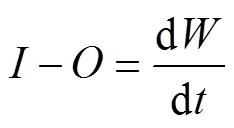
式中为流入量,m³;为流出量,m³;为储水量,m³;为时间,d。
1.1 田间水平衡模拟计算
将水稻田视为一个控制系统,以田间储水水深作为状态变量,表示在系统中具有积累效应的变量。反映状态变量输入或输出速度的变量称为速率变量。状态变量与各速率变量的关系用水量平衡方程表示为

式中S1、S分别为时段初与时段末的田间储存水深,等于土壤水储存量及田间水层的水量之和;P为第时段降雨量;IR为第时段灌溉引水量;ET为第时段作物蒸发蒸腾量;DP为第时段深层渗漏量;DR为第时段排水量。各变量单位均以单位面积上的水深mm表示。
蒸发蒸腾量为

(4)
(5)
式中K为水稻作物系数,无量纲;K为水分胁迫因子,无量纲;ET0为参考作物蒸发蒸腾量,通过气象数据由彭曼公式计算得到,mm;θθθ分别为土壤体积含水率、凋萎系数、含水率临界值及田间持水量,mm3/ mm3;为作物可利用水分数,水稻取0.2[21],无量纲。
深层渗漏量为

式中0为土壤达到饱和含水率θ时的日渗漏量,通过试验等方式确定,mm。假定深层渗漏量只在土壤含水率大于田间持水量时发生,当土壤含水率在饱和含水率和田间持水量之间时,深层渗漏量与土壤含水率成线性关系。
排水量为

式中H为第时段排水口高度,由雨后最大允许蓄水深度确定,mm。当田间储存水深S高于排水口高度H时,会产生排水量,反之无排水量。
灌溉需水量为

式中DI为第时段水稻灌溉需水量,mm;IHmint为第时段灌溉下限,mm;IHmaxt为第时段灌溉上限,mm。
1.2 塘堰水平衡调节计算
塘堰具有积蓄雨水和灌溉回归水的功能,在以塘堰为主体的灌溉系统中,根据水量平衡原理可得

式中V为第时段塘堰蓄水量;W为第时段塘堰来水量,包括塘面集水量、水田排水量以及旱地及非耕地地表径流量;WI为第时段塘堰供水量;EL为第时段塘堰损失水量;X为第时段塘堰泄水量。各单位均以m³表示。
(10)

式中A为塘堰面积,m2;RO为旱地及非耕地地表径流量,采用降雨径流法计算,mm;为降雨入渗系数,当P<5 mm时,无径流与入渗产生,当5 mm≤P≤50 mm时,0.8,当P>50 mm,0.7[22];A为水田面积,m2;A为旱地及非耕地面积,m2;为塘堰有效集雨面积与灌区面积之比,主要取决于地形因素。
(12)
式中E为第时段塘堰蒸发量,采用蒸发皿折算系数法计算,mm;L为第时段塘堰渗漏量,通过试验观测估算,mm。
塘堰在某一时段的具体调节计算过程如下:
1.3 模型结构及模拟过程
系统动力学是一门研究系统动态复杂性的科学,采用定性与定量结合,系统综合推理的方法,模拟系统在不同策略参数输入时的行为和趋势[23]。该方法擅长处理高阶次、非线性、时变的复杂问题,是研究水资源系统的重要方法之一[24-26]。构建系统动力学模型一般步骤是:首先明确问题,根据问题特征绘制其因果关系图;然后在此基础上,进一步根据结构进行系统动力学模型流程图的绘制,输入各变量关系式,建立系统动力学模型;最后进行仿真试验,修改参数及验证模型,并在模型仿真结果的基础上分析战略与决策[27]。
本文采用Vensim作为建立模型的平台,该软件具有可视化界面,用户可以根据具体问题采用概念化、模块化描述系统的结构,得到随时间连续变化的系统图像,并模拟系统的动态行为。稻田塘堰系统水转化模型结构见图1,模型中采用的参数有:
1)状态变量:田间储存水深、塘堰蓄水量;
2)速率变量:降雨量、蒸发蒸腾量、深层渗漏量、排水量、塘堰来水量、塘堰供水量、塘堰损失水量、塘堰泄水量;
3)辅助变量:其他变量。
3种变量分别对应着状态方程、速率方程和辅助方程。设定非线性函数关系,确定估计参数,并为所有变量的初始值、表函数赋值。对模型设定不同的调控参数,从而有效刻画各个调控参数对稻田塘堰系统水转化动态过程的影响。
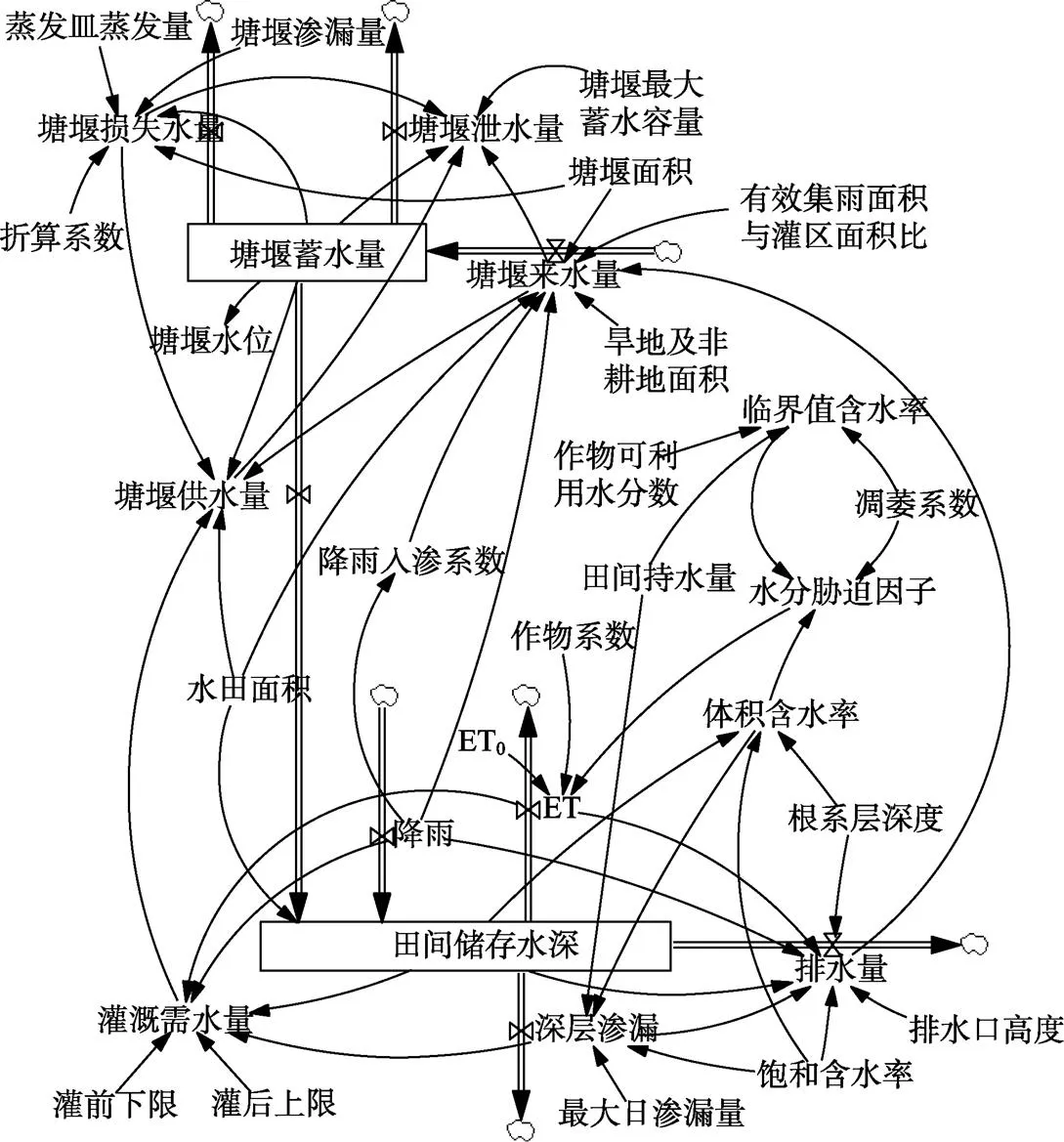
注:ET0为参考作物蒸发蒸腾量,mm;ET为作物蒸发蒸腾量,mm。
2 实例分析
2.1 研究区域概述
研究区域位于漳河水库三干渠中游,地处112°15′~112°16′E,30°42′~30°44′N,是由陈池支渠、洪庙支渠及五洋公路围成的封闭区域。该区域属于亚热带大陆性气候,多年平均气温约16 ℃,多年平均降雨量为947 mm,85%的降雨集中于4—10月。区域总面积151 hm2,主要灌溉作物为中稻,农民普遍采用浅水灌溉的方式,除分蘖末期适当晒田和黄熟期落干外,田面保持0~50 mm的水层。区域内部分布着大小塘堰145口,主要通过排水沟渠连通,总调蓄能力可以达到155 283 m³。据调查了解,为降低灌溉成本,除泡田期引用渠道水泡田外,农民优先使用塘堰的水灌溉,当塘堰供水不足时再考虑渠首放水,塘堰供水发挥着重要作用。
2.2 输入资料与参数估计
气象资料来源于漳河团林试验站2015年监测的数据。水面蒸发折算系数取自宜昌蒸发站的分析结果[28]。水稻根系层深度取300 mm[29],作物系数由试验站监测资料确定[30]。结合漳河灌区实际,中稻生育期划分及不同灌溉模式下的水层控制标准参考见表1[31]。由于本模型在水稻插秧过后开始模拟,初始土壤处于饱和状态,且有田间水层深度40 mm。
研究区域以黏壤土为主,取样分析得到凋萎系数:0.15 mm3/mm3;田间持水量:0.37 mm3/mm3;饱和含水率:0.45 mm3/mm3。由于该区域长期种植水稻,渗漏强度较小,通过布置渗漏井观测得到土壤达到饱和含水率时的深层渗漏量为2 mm/d。模型中假设各个田块的径流出流量直接汇入排水沟渠,并最终通过塘堰收集。考虑到局部区域的地表径流量不能被塘堰拦蓄,根据漳河灌区典型村值的计算结果[32],结合该区域地形条件,取0.95。在区域内实地监测塘堰水位,根据各塘堰水位容量关系,计算得到区域塘堰的初始蓄水量,约为塘堰最大蓄水容量的70%。

表1 稻田不同灌溉模式下水层控制标准
注:H为水稻根系层深度,mm;sat为饱和含水率,mm3·mm-3。
Note:His root depth of rice, mm; is saturated water content, mm3·mm-3.
3 结果与分析
3.1 模型验证
根据研究区域内塘堰的整体特征和分布情况,从中抽取16个典型塘堰,实地测量每个典型塘堰的水面面积、边坡系数和最大蓄水容量,确定每个典型塘堰水位容量关系。每个典型塘堰内布设有量水尺,在2015年中稻生育期内逐日观测塘堰水位。通过每个塘堰的水位容量关系,可以得到16个典型塘堰蓄水量日变化过程。将区域内所有塘堰概化为一个大塘堰,作为灌溉系统的主体水源。在同一时段,假设大塘堰的总蓄水量与16个典型塘堰的总蓄水量成一定比例,即可以由16个典型塘堰的总蓄水量推求得到大塘堰的总蓄水量,再通过大塘堰的水位容量关系,可以得到区域的塘堰水位,由此来验证模拟的塘堰水位。采用复相关系数2、Nash-Sutcliffe 系数和均方根误差(root-mean-square error,RMSE)评价模拟值与实测值的相似度[33]。
利用2015年中稻生育期内塘堰日水位实测值与模拟值对比,如图2所示,从直观上看模拟结果与实测结果拟合较好。2和Nash-Sutcliffe系数的理想值为1,均方根误差RMSE的理想值为0。2015年中稻生育期内塘堰日水位模拟结果的2值和值分别为0.90和0.79,RMSE值为0.155 m/d,模拟结果具有较高精度,说明模型可以反映区域塘堰水位的动态变化过程。
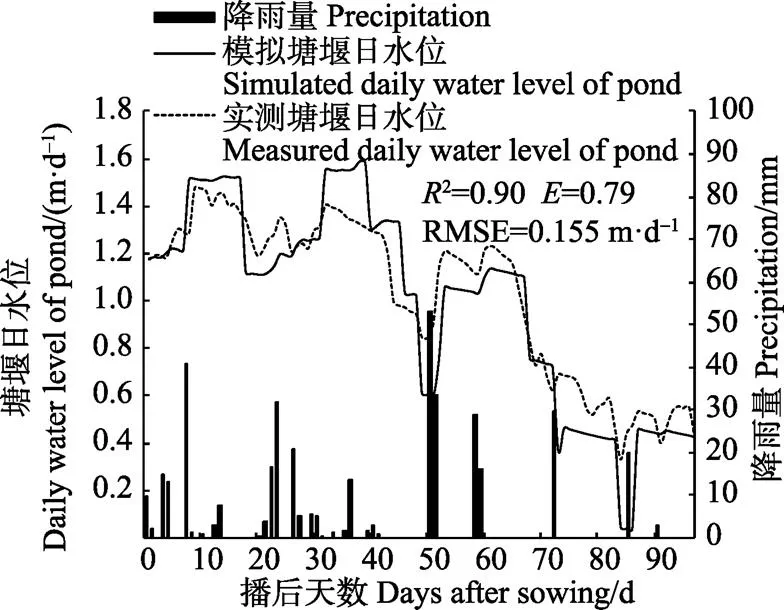
注:E是Nash-Sutcliffe系数;RMSE是均方根误差。
3.2 塘堰不同调蓄方式下的系统动态模拟
为了研究塘堰不同调蓄方式对稻田塘堰系统水转化的影响,在目前实施的浅水灌溉模式下,模拟了3种塘堰调蓄方式。第1种是可以使用塘堰所有的蓄存水量,此方式接近目前的实际调蓄方式;第2种是采用部分调蓄的方式,考虑到生态养殖等要求,保证塘堰蓄水量不得低于最大蓄水容量的60%;第3种是灌区内无塘堰可以使用,实行雨养。基于2015年资料模拟分析水稻生育期内田间储存水深变化,如图3所示。

图3 浅水灌溉塘堰不同调蓄方式下稻田储存水深变化
由图3模拟结果可知,浅水灌溉下,当塘堰完全调蓄时,水稻在落干前的田间储存水深一直处于饱和含水率之上,作物得到充分灌溉。当塘堰部分调蓄时,田间储存水深在第72天低于含水率临界值,作物发生水分胁迫,在生育后期出现供水不足的情况。当没有塘堰调蓄时,田间储存水深在第45天开始低于含水率临界值,作物缺水天数明显增多。这表明,塘堰的调蓄作用能够有效延长作物缺水天数,当发生干旱缺水时,若能充分发挥塘堰就近取水、灌水及时的特点,合理地调配塘堰灌溉系统,可以缓解作物关键期无水可用的情况,并使灌区管理部门有时间拟定相关应对措施。
3.3 田间不同灌溉模式下的系统动态模拟
为了研究不同灌溉模式对稻田塘堰系统水转化的影响,当塘堰完全调蓄时,选取用水管理部门推广较为广泛的湿润灌溉与间歇灌溉模式,对比浅水灌溉,基于2015年资料模拟分析水稻生长季塘堰蓄水量变化,如图4所示。从模拟结果可以发现,在生育早期3种灌溉模式下的塘堰蓄水量变化一致;发育期润湿灌溉下的塘堰蓄水量相对最小,而间歇灌溉模式下塘堰产生泄水;生育中后期浅水灌溉下塘堰蓄水量下降最为明显。从塘堰最低蓄水量占塘堰最大蓄水容量的比例来看,浅水灌溉、湿润灌溉、间歇灌溉分别为2.0%、18.9%和41.3%。这表明,实行间歇灌溉模式下,塘堰可以长期保持一定的蓄水量,为塘堰水产养殖、排水水质处理等生态功能提供保障。
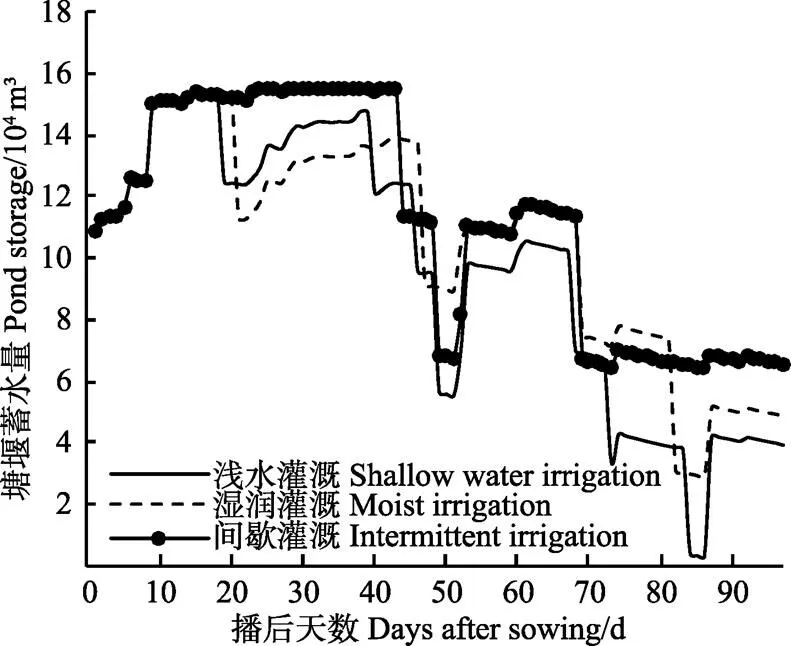
图4 不同灌溉模式下塘堰蓄水量变化
表2展示了水稻生长季不同灌溉模式下塘堰的水平衡要素和有效水利用率。表中蓄水量变化量指黄熟期结束后,塘堰最终蓄水量与初始蓄水量之差,有效水利用率指供水量占总水量的比例,其中总水量为来水量减去蓄水量变化量。由表中模拟数据可知,3种灌溉模式下,塘堰来水量是浅水灌溉>间歇灌溉>湿润灌溉,供水量以浅水灌溉>湿润灌溉>间歇灌溉,有效水利用率分别为84.7%、80.9%和67.7%。由于间歇灌溉的灌溉下限明显低于其他灌溉模式,具有较大的蓄积雨水的空间,在各个阶段灌溉需水量相对较小,所以塘堰有效水利用率最小。
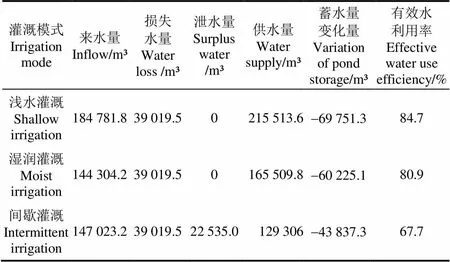
表2 不同灌溉模式下塘堰水平衡要素及有效水利用率
4 结 论
1)本文分析了南方水稻灌区水平衡机制,利用Vensim软件建立了稻田塘堰系统水转化系统动力学模型。运用研究区域塘堰日水位观测资料检验,模拟结果的2为0.90,Nash-Sutcliffe系数为0.79、相对均方根误差为0.155 m/d,证明模型可以定量描述稻田塘堰系统的水转化关系。
2)模拟分析了塘堰调蓄方式及灌溉模式对稻田塘堰系统水转化的影响。结果表明,在浅水灌溉模式下,塘堰在完全调蓄时可以保障作物充分灌溉,在部分调蓄与不调蓄时作物分别在第72天和45天发生水分胁迫,塘堰灌溉对保证作物正常生长天数具有显著效果。当塘堰完全调蓄时,在浅水灌溉、湿润灌溉及间歇灌溉模式下,塘堰最低蓄水量占最大蓄水量的比例分别为2.0%、18.9%和41.3%,塘堰的有效水利用率分别为84.7%、80.9%和67.7%。实行间歇灌溉,塘堰可以长期保持一定的蓄水量,为塘堰水产养殖、排水水质处理等生态功能提供保障。
本文建立的系统动力学模型所需参数较少且易于掌握,在南方水稻灌区塘堰灌溉系统中具有良好的适用性。随着研究尺度的扩大,在灌区不同的地理环境下,如何科学分析农田、灌排沟渠、水库塘堰之间的水转化关系,提高灌溉水利用效率,还有待进一步研究。
[1] Moussa R, Voltz M, Andrieux P. Effects of the spatial organization of agricultural management on the hydrological behaviour of a farmed catchment during flood events[J]. Hydrological Processes, 2002, 16(2): 393-412.
[2] Davies B R, Biggs J, Williams P J, et al. A comparison of the catchment sizes of rivers, streams, ponds, ditches and lakes: implications for protecting aquatic biodiversity in an agricultural landscape[J]. Hydrobiologia, 2008, 597(1): 7-17.
[3] 蔡明科,魏晓妹,粟晓玲. 灌区耗水量变化对地下水均衡影响研究[J]. 灌溉排水学报,2007,26(4):16-20. Cai Mingke, Wei Xiaomei, Su Xiaoling. Influence of irrigation area water consumption change to ground water balanced[J]. Journal of Irrigation and Drainage, 2007, 26(4): 16-20. (in Chinese with English abstract)
[4] Janssen M, Lennartz B, Wöhling T. Percolation losses in paddy fields with a dynamic soil structure: Model development and applications[J]. Hydrological Processes, 2010, 24(7): 813-824.
[5] Liu L, Luo Y, He C, et al. Roles of the combined irrigation, drainage, and storage of the canal network in improving water reuse in the irrigation districts along the lower Yellow River, China[J]. Journal of Hydrology, 2010, 391(1): 157-174.
[6] Siderius C, Boonstra H, Munaswamy V, et al. Climate-smart tank irrigation: A multi-year analysis of improved conjunctive water use under high rainfall variability[J]. Agricultural Water Management, 2015, 148(1): 52-62.
[7] Huang S L, Lee Y C, Budd W W, et al. Analysis of changes in farm pond network connectivity in the peri-urban landscape of the Taoyuan area, Taiwan[J]. Environmental Management, 2012, 49(4): 915-928.
[8] Bonachela S, Juan M, Casas J J, et al. Pond management and water quality for drip irrigation in Mediterranean intensive horticultural systems[J]. Irrigation Science, 2013, 31(4): 769-780.
[9] Lezcano J M, González F, Ballester A, et al. Mechanisms
involved in sorption of metals by chemically treated waste biomass from irrigation pond[J]. Environmental Earth Sciences, 2016, 75(10): 1-12.
[10] Palanisami K, Giordano M, Kakumanu K R, et al. The stabilization value of groundwater: evidence from Indian tank irrigation systems[J]. Hydrogeology Journal, 2012, 20(5): 933-941.
[11] Mushtaq S, Dawe D, Lin H, et al. An assessment of the role of ponds in the adoption of water-saving irrigation practices in the Zhanghe Irrigation System, China[J]. Agricultural Water Management, 2006, 83(1): 100-110.
[12] Anbumozhi V, Matsumoto K, Yamaji E. Towards improved performance of pirrigation tanks in semi-arid regions of india: modernization opportunities and challenges[J]. Irrigation and Drainage Systems, 2001, 15(4): 293-309.
[13] 蒋尚明,金菊良,许浒,等. 基于径流曲线数模型的江淮丘陵区塘坝复蓄次数计算模型[J]. 农业工程学报,2013,29(18):117-124. Jiang Shangming, Jin Juliang, Xu Hu, et al. Computational model of pond re-storage times in Jianghuai hilly area based on SCS model[J]. Transactions of the Chinese Society of Agricultural Engineering (Transactions of the CSAE), 2013, 29(18): 117-124. (in Chinese with English abstract)
[14] Shao Dongguo, Tan Xuezhi, Liu Huanhuan, et al. Performance analysis of on-farm irrigation tanks on agricultural drainage water reuse and treatment[J]. Resources, Conservation and Recycling, 2013, 75(75): 1-13.
[15] 于颖多,焦平金,许迪,等. 排水循环灌溉驱动的稻区水循环模型与评价[J]. 农业工程学报,2016,32(11):138-143. Yu Yingduo, Jiao Pingjin, Xu Di, et al. Water cycle model and its assessment under cyclic irrigation of drainage water in paddy district[J]. Transactions of the Chinese Society of Agricultural Engineering (Transactions of the CSAE), 2016, 32(11): 138-143. (in Chinese with English abstract)
[16] Liebe J, van de Giesen N, Andreini M. Estimation of small reservoir storage capacities in a semi-arid environment: A case study in the Upper East Region of Ghana[J]. Physics and Chemistry of the Earth, 2005, 30(6):448-454.
[17] 胡能杰,邵东国,陈述,等. 基于随机降雨模拟的灌区塘坝蓄水方案优化[J]. 农业工程学报,2016,32(18):105-110. Hu Nengjie, Shao Dongguo, Chen Shu, et al. Optimal water store control of ponds in irrigation district based on stochastic precipitation simulation[J]. Transactions of the Chinese Society of Agricultural Engineering (Transactions of the CSAE), 2016, 32(18): 105-110. (in Chinese with English abstract)
[18] Chen Shu, Shao Dongguo, Li Xudong, et al. Simulation- optimization modeling of conjunctive operation of reservoirs and ponds for irrigation of multiple crops using an improved artificial bee colony algorithm[J]. Water Resources Management, 2016, 30(9): 2887-2905.
[19] Kim T C, Gim U S, Kim J S, et al. The multi-functionality of paddy farming in Korea[J]. Paddy and Water Environment, 2006, 4(4): 169-179.
[20] 毛战坡,尹澄清,单宝庆,等. 水塘系统对农业流域水资源调控的定量化研究[J]. 水利学报,2003,34(12):76-83. Mao Zhanpo, Yin Chengqing, Shan Baoqing, et al. Regulation function of multi-pond system for water resources in a watershed[J]. Journal of Hydraulic Engineering, 2003, 34(12): 76-83. (in Chinese with English abstract)
[21] Khan S, Luo Y, Ahmad A. Analysing complex behaviour of hydrological systems through a system dynamics approach[J]. Environmental Modelling & Software, 2009, 24(12): 1363-1372.
[22] 张新. 基于系统动力学的稻田回归水模拟[D]. 武汉:武汉大学,2005.
Zhang Xin. Simulation Return Flow of Paddy Rice Based on System Dynamics Approach[D]. Wuhan: Wuhan University, 2005. (in Chinese with English abstract)
[23] 王其藩. 系统动力学:修订版[M]. 上海:上海财经大学出版社,2009.
[24] Niazi A, Prasher S O, Adamowski J, et al. A system dynamics model to conserve arid region water resources through aquifer storage and recovery in conjunction with a dam[J]. Water, 2014, 6(8): 2300-2321.
[25] Ryu J H, Contor B, Johnson G, et al. System dynamics to sustainable water resources management in the eastern snake plain aquifer under water supply uncertainty 1[J]. Jawra Journal of the American Water Resources Association, 2012, 48(6): 1204-1220.
[26] Han S J, Suh K, Jang T I, et al. Economic analysis of wastewater reuse systems for agricultural irrigation using a system dynamics approach[J]. Journal of the Korean Society of Agricultural Engineers, 2013, 55(2): 9-20.
[27] 崔远来,张新,罗玉峰,等.稻田回归水模拟及其评价[J]. 灌溉排水学报,2005,24(5):1-4. Cui Yuanlai, Zhang Xin, Luo Yufeng, et al. Simulation and evaluation of return flow in rice paddy[J]. Journal of Irrigation and Drainage, 2005, 24(5): 1-4. (in Chinese with English abstract)
[28] 王远明,,李成荣. 宜昌站水面蒸发折算系数分析[J]. 人民长江,1999,30(1):41-42. Wang Yuanming, Zhang Yi, Li Chengrong. The study of pan coefficients of evaporation pans of water[J]. Yangtze River, 1999, 30(1): 41-42.
[29] 王传娟,王少丽,陈皓锐,等. 稻田水量调控模拟计算及分析[J]. 中国农村水利水电,2016(8):137-143. Wang Chuanjuan, Wang Shaoli, Chen Haorui et al. The simulation and analysis rainfall storage and water conservation[J]. China Rural Water and Hydropower, 2016 (8): 137-143. (in Chinese with English abstract).
[30] 李远华. 节水灌溉理论与技术[M]. 武汉:武汉水利电力大学出版社,1999.
[31] 张祖莲,薛继亮. 水稻间歇灌溉试验研究[J]. 节水灌溉,2001(6):23-24. Zhang Zulian, Xue Jiliang. Experimental study on intermittent irrigation for paddy[J]. Water Saving Irrigation, 2001(6): 23-24. (in Chinese with English abstract).
[32] 郑祖金,崔远来,董斌,等. 灌区塘堰拦蓄地表径流能力的研究[J]. 中国农村水利水电,2005(1):39-40. Zheng Zujin, Cui Yuanlai, Dong Bin, et al. Study on the capacity of surface runoff interception by ponds in irrigation district[J]. China Rural Water and Hydropower, 2005(1): 39-40. (in Chinese with English abstract).
[33] Wu G, Li L, Ahmad S, et al. A dynamic model for vulnerability assessment of regional water resources in arid areas: a case study of bayingolin, China[J]. Water Resources Management, 2013, 27(8): 3085-3101.
Simulation and verification of water transformation of rice paddy and pond system based on system dynamics
Hu Nengjie, Shao Dongguo※, Chen Shu, Le Zhihua, Nong Xizhi
(430072,)
Ponds are widely distributed in Southern China. Considering the regulatory role of pond, Vensim software was used to build a system dynamic model to simulate water transformation in paddy and pond system, based on the system dynamic approach and water balance method. It was assumed that runoff from each land unit directly fed into drainage canal without flowing through other fields. The physical processes, such as irrigation, evapotranspiration, deep percolation, inflow and outflow of pond, were calculated in the model. In addition, various scenarios could be set to research the variation of the system with control factors. The proposed model was applied to simulate water transformation during the growing period of rice in Zhanghe irrigation district to examine its feasibility. The study area features a subtropical continental climate with an average annual precipitation of 947 mm, 85% of which occurs between April and October. There are 145 ponds with the storage capacity of 155 283 cubic meters, which are important for ensuring an adequate water supply for crops. In the simulation, all the ponds were integrated as a large pond. And water storage was obtained from the relation curve between water level and storage. The results showed a good agreement between the observed and simulated daily water level of pond: coefficient of determination of 0.90, coefficient of efficiency of 0.79 and root-mean-square error of 0.155 m/day. To estimate the significance of pond irrigation system for agriculture irrigation, 3 different pond operation modes were set and simulated: 1) pond supply with total operation, 2) pond supply with partial operation, and 3) pond closed irrigation system. The result showsed that pond operation could ensure full irrigation of rice, and water stress occurred for 72 days under partial operation, closing pond irrigation system was bad for the growth of rice. Therefore, the pond irrigation system had a significant effect on ensuring the normal growth of crop. Additionally, water transformation was simulated under 3 different irrigation modes. From the results, in the early growth period, pond storage was consistent under 3 irrigation modes. However, during the developmental stage, pond storage was the smallest under moist irrigation and produced surplus water under intermittent irrigation. Pond storage decreased significantly under the shallow water irrigation in the late growth stage. From the perspective of pond inflow, shallow water irrigation was the best, followed by intermittent irrigation and moist irrigation. For the water supply, shallow water irrigation was also the best, followed by moist irrigation and intermittent irrigation, and effective water use efficiencies were 84.7%, 80.9% and 67.7%, respectively. The proportions, calculated by the minimum pond storage dividing pond capacity, were 2.0%, 18.9% and 41.3% for shallow water irrigation, wet irrigation and intermittent irrigation,respectively. This shows that under intermittent irrigation mode, pond can maintain a certain amount of water for a long period of time, which provides a scope for aquaculture and drainage water treatment. This study provides valuable information for the rational use of water resources and irrigation management in paddy rice and pond system.
water levels; water management; systems sciences; pond irrigation system; system dynamics; water balance; simulation
10.11975/j.issn.1002-6819.2017.12.017
P333.1; N941.3; S274.2
A
1002-6819(2017)-12-0130-06
2016-12-23
2017-03-10
国家自然科学基金重点项目(51439006);国家自然科学基金面上项目(51379150);“十三五”国家重点研发计划课题(2016YFC0400101)
胡能杰,男,湖北黄石人,主要从事水资源高效利用与环境保护研究。武汉 武汉大学水资源与水电工程科学国家重点实验室,430072。Email:nengjiehu@163.com
邵东国,男,湖南常德人,教授,博士生导师,主要从事水资源高效利用及其生态环境效应研究。武汉 武汉大学水资源与水电工程科学国家重点实验室,430072。Email:dgshao@whu.edu.cn
胡能杰,邵东国,陈 述,乐志华,农翕智. 基于系统动力学的稻田塘堰系统水转化模拟及验证[J]. 农业工程学报,2017,33(12):130-135. doi:10.11975/j.issn.1002-6819.2017.12.017 http://www.tcsae.org
Hu Nengjie, Shao Dongguo, Chen Shu, Le Zhihua, Nong Xizhi.Simulation and verification of water transformation of rice paddy and pond system based on system dynamics[J]. Transactions of the Chinese Society of Agricultural Engineering (Transactions of the CSAE), 2017, 33(12): 130-135. (in Chinese with English abstract) doi:10.11975/j.issn.1002-6819.2017.12.017 http://www.tcsae.org
